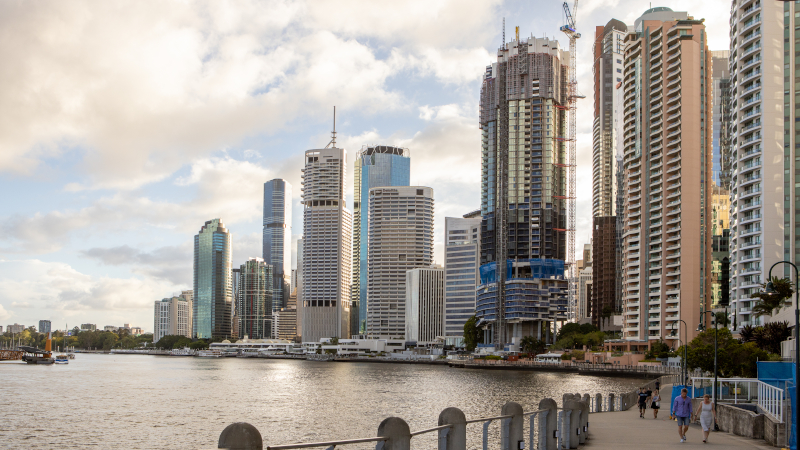[ad_1]
Queensland’s influx of interstate residents is influencing dwelling design, with owner-occupiers and investors gravitating towards larger and more luxurious apartments.
Queensland’s influx of interstate residents is influencing dwelling design, with owner-occupiers and investors gravitating towards larger and more luxurious apartments.
Across Australia, Urbis’ latest Apartments Essentials report found that 27 per cent of apartments being developed had three bedrooms or more, 55 per cent contained two bedrooms and 18 per cent were either one bedroom or studio dwellings.
That proportion of three bedroom or larger apartments was the highest level since Urbis began tracking the market in 2015.
Apartment size is also trending upwards, with the average two bedroom, two bathroom apartment sold in the year to the end of September rising from 86 square metres to 91sqm, and three bedroom apartments increasing from 127sqm to 134sqm.
That trend is even more prevalent in South East Queensland, according to Urbis director Paul Riga, with apartments increasingly being seen as long-term living options, a phenomenon that was changing the way developers build.
Urbis’ research showed the split of apartment buyers in Queensland was now 50:50, with an equal proportion of sales in 2021 going to owner-occupiers and investors.
Previously, investors made up a bigger cohort, according to Mr Riga.
“Developers are aware of this move and are now looking closer at the finer details and size,” Mr Riga said.
“Across the board, we are seeing a lower proportion of one-bedroom units being built; with a higher number of three to four-bedroom options.
“Apartments are no longer just an investment option to house students; they are now seen as family homes.
“This is particularly the case in the Southern Gold Coast, where price points for apartments are leading the rest of the nation.”
Mr Riga told a recent virtual market update hosted by Dye & Durham that the latest data showed interstate migration was continuing to move in the right direction for Brisbane and the Gold Coast.
“There is huge interest in Queensland, and for people that want to come to the South East especially,” he said.
“We have seen enquiry levels grow and even increase as we get towards the end of the year.
“The 2032 Olympics have definitely bolstered sentiment in the local market here.
“Different levels of government and corporations are getting into the mix and adding to the activity.
While the Gold Coast has been a runaway leader in apartment sales in the past 12 months, the pace of transactions in Brisbane has almost doubled from levels recorded in 2020-21, particularly since it was confirmed that Queensland would host the Olympics.
Urbis’ research showed that earlier this year, 18 per cent of apartments on the market were being cleared on a quarterly basis, but in the three months to the end of September, that level lifted to 39 per cent.
Prior to the pandemic, Mr Riga said new apartment projects were transacting at 10 per cent of available product per quarter.
Mr Riga said developers in Brisbane were reacting swiftly to the sales boom, with the number of new projects launched in the third quarter of 2021 triple that of the same time last year.
“The market has completely changed for apartments now, especially in inner Brisbane,” he said.
What we are seeing is mature owners take advantage of the new house price points and move to downsize.
“Because of this, almost 60 per cent of the market is made up of owner-occupiers, previously in 2018, the largest slice was investors at 40 per cent.
“In Queensland, it has been a record quarter for apartment sales and the highest level of transactions since we started monitoring the market in 2014.”
Peter Maloney, the managing director of online property settlements and legal support firm Dye & Durham, said Queensland’s elevated residential property transaction activity was driving big change not only for developers but also for the buying process.
“There is no doubt that there is a significant boom; when we look at it, it is really in price and volume in particular for the Brisbane market when compared to its interstate peers,” Mr Maloney said at a virtual market update hosted by Dye & Durham recently.
“What has been really clear is that over the past 12 months, those cities who have experienced some tough lockdowns have been worse off than those with less social distancing,” Mr Maloney said.
“Cities with no material social distancing have seen the greater growth in price and volumes – and in Brisbane, it isn’t letting up; here we are seeing a twenty-year high.
“Demand is also meeting volume on the market in Queensland with the average property sitting on the market for just 22 days.
“That urgency to buy is translating into the demand for online verification through our portals at Dye & Durham.
“Instead of going down to Australia post to verify, buyers are now opting for online verification so they can act quickly and secure the property within the day.”
[ad_2]
Source link

